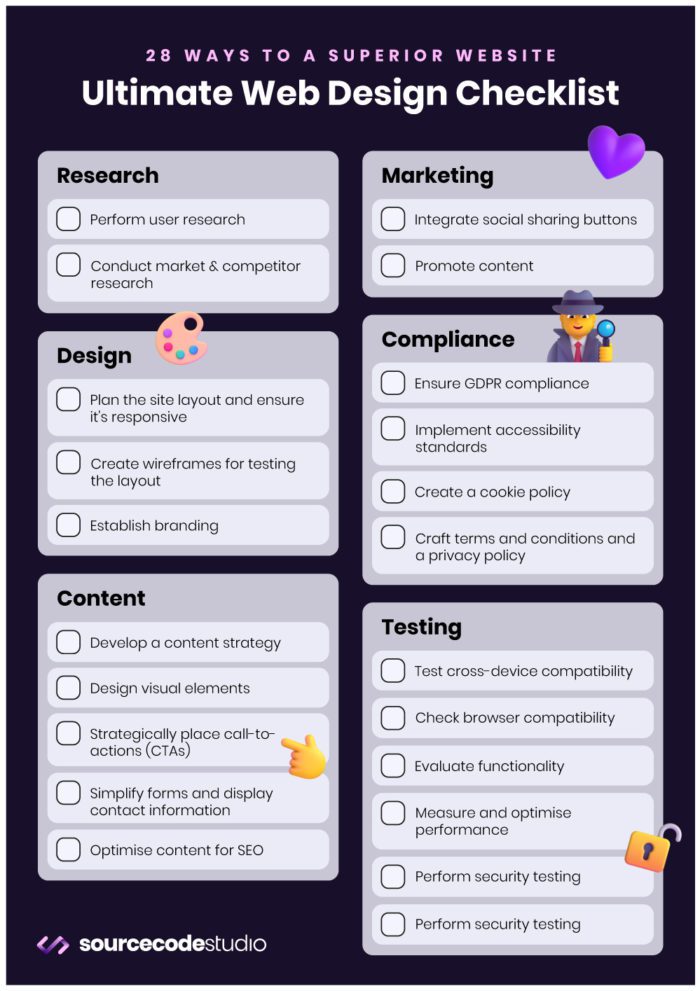In the complex journey of website creation, it’s easy for teams to find themselves overwhelmed by the multitude of tasks involved. However, with a flexible checklist tailored to your unique business and customer needs, you can streamline your design process and ensure that no crucial steps are overlooked in the creation of a website that resonates with your users.
Our extensive 28-task web design checklist serves as your roadmap to check off vital phases in website design and development, setting the stage for a seamless and successful launch.
A Versatile 28-Step Web Design Checklist
Our checklist is designed with adaptability in mind—customisable to suit your specific business and user requirements. You have the flexibility to follow the list chronologically, ticking off items as you go, or focus on the steps most pertinent to your current needs.
We’ll guide you through essential research, design, content, marketing, compliance, and testing stages, ensuring that you cover all bases to construct an effective site for your users.
Download your complimentary web design checklist (as displayed below) to track your progress and mark off tasks as they are completed.
Content Quick links
Research
Prioritise Research for Successful Web Design
Before delving into the design process, it’s crucial to prioritise thorough research. This preliminary step helps you understand your target audience and ensures that your website will meet their expectations and needs.
1. Carry out User Research
Employ qualitative and quantitative user research methods to gain insights into customer problems and align your site design with solutions.
- Understand your users’ preferences, behaviour, and pain points.
- Validate early-stage ideas through user feedback.
- Utilise tools like Hotjar Surveys, diary studies, interviews, and focus groups to gather valuable insights.
2. Conduct Market & Competitor Research
Market and competitor research is essential for positioning your website effectively within your industry and distinguishing it from competitors.
- Dive into market research to gauge your website’s viability and narrow down your target audience.
- Read industry reports, create user personas, and analyse market data.
- Identify key competitors and perform competitor analysis to identify strengths and weaknesses.
Design
Plan Your Site Layout and Branding Elements for a Great User Experience (UX) and User Interface (UI)
3. Plan Your Site Layout (and Make It Responsive)
Plan your site layout thoughtfully to provide an excellent user experience (UX) and make it responsive for various devices.
Pro tip: Start planning your mobile interface for a responsive site, adjusting elements for optimal engagement on smaller screens.
- Assess available website templates for customisability.
- Decide on necessary pages like the homepage, ‘About Us,’ product/service pages, and checkout pages.
- Gather inspiration from exceptional website designs and common design patterns.
- Roughly sketch the organisation of each page, emphasising clear headers, navigation menus, call-out sections, buttons, forms, and footers.
4. Utilise Wireframes to Test Your Layout
Use wireframes, two-dimensional illustrations, or ‘website blueprints,’ to outline your web page structure, information architecture, and desired user flows.
Recommended wireframe tools: Maze, Figma, InVision, Proto, Adobe XD.
- Create wireframes to validate and test basic interfaces early in the design process.
- Avoid including branding elements or graphics in wireframes.
- Wireframes help identify usability problems before investing substantial time and resources into your website.
5. Establish Your Branding
Establish branding decisions early to ensure your website reflects your product vision and provides a cohesive user experience (UX).
- Create a company logo for your website, either by hiring a professional designer or using online tools like Canva or Snappa.
- Choose up to three web-safe fonts like Arial, Verdana, and Tahoma for readability.
- Maintain a consistent colour palette that aligns with your branding, considering HEX codes for uniformity (ideally, limit your palette to three or four colours).
Content
Craft Compelling Content to Engage Your Audience
In this section, we’ll delve into the crucial aspects of content creation that will capture your audience’s attention and keep them engaged on your website.
11. Content Strategy
Plan your content strategy carefully to ensure it resonates with your target audience and supports your website’s goals.
Pro tip: Use a clear hierarchy with headings and subheadings to enhance readability.
- Develop high-quality, engaging, and relevant content.
- Utilise a clear content hierarchy with headings and subheadings.
- Ensure content is easy to scan and read.
12. Visual Design
Maintain a consistent visual style, including colours, fonts, and imagery, to provide an engaging and cohesive user experience (UX).
- Use a consistent visual style, including colours, fonts, and imagery.
- Utilise whitespace effectively to enhance readability.
- Opt for high-resolution images and graphics.
13. Call-to-Action (CTA) Placement
Strategically place CTAs throughout your website to guide users towards desired actions. Make CTA buttons stand out with contrasting colours and persuasive copy.
- Strategically place CTAs to guide users towards desired actions.
- Make CTA buttons stand out with contrasting colours and persuasive copy.
14. Forms and Contact Information
Streamline forms for user convenience, and ensure contact information, including phone numbers and email addresses, is clearly displayed.
- Simplify forms for user convenience.
- Clearly display contact information, including phone numbers and email addresses.
15. SEO Optimisation
Conduct keyword research and incorporate relevant keywords into your content. Optimise meta titles, descriptions, and alt text for images. Set up a sitemap and submit it to search engines.
- Conduct keyword research and incorporate relevant keywords into your content.
- Optimise meta titles, descriptions, and alt text for images.
- Set up a sitemap and submit it to search engines.
Marketing
Strategise Your Marketing Efforts for Maximum Impact
In this section, we’ll explore essential marketing strategies to boost your website’s visibility and attract a broader audience.
16. Social Sharing Integration
Integrate social sharing buttons throughout your website to encourage visitors to share your content with their networks. Additionally, display your social media profiles prominently for easy access.
- Implement social sharing buttons to promote content sharing.
- Display social media profiles for enhanced user engagement.
17. Content Promotion
Effectively promote your website’s content through various channels, including social media, email marketing, and guest blogging, to reach a wider audience and drive traffic.
- Utilise social media platforms for content promotion.
- Implement email marketing campaigns to engage with your audience.
- Explore guest blogging opportunities to expand your reach.
18. Search Engine Optimization (SEO)
Optimise your website for search engines by conducting keyword research, improving on-page SEO elements, and building quality backlinks to increase organic traffic.
- Conduct thorough keyword research to target relevant search terms.
- Optimise on-page elements such as meta titles, descriptions, and headers.
- Develop a backlink strategy to enhance your website’s authority.
Compliance
Ensure Your Website Complies with Legal and Regulatory Standards
In this section, we’ll cover the essential aspects of compliance to keep your website in line with legal and regulatory requirements.
19. GDPR Compliance
If your website collects user data, especially from European visitors, ensure compliance with the General Data Protection Regulation (GDPR). This includes obtaining explicit user consent for data collection and providing options for data removal.
- Obtain explicit user consent for data collection.
- Provide clear options for users to request data removal.
20. Accessibility Compliance
Make your website accessible to all users, including those with disabilities, by adhering to accessibility standards (e.g. WCAG). Ensure features like alt text for images and keyboard navigation are in place.
- Follow accessibility standards such as WCAG.
- Implement features like alt text for images and keyboard navigation.
21. Cookie Policy
If your website uses cookies, inform users about their purpose and obtain their consent for cookie usage as per regulations. Provide an easily accessible cookie policy page.
- Inform users about cookie usage and purpose.
- Obtain user consent for cookies and provide a dedicated policy page.
22. Terms and Conditions and Privacy Policy
Ensure your website has clear and comprehensive terms and conditions and a privacy policy in place. These documents outline user rights, responsibilities, and data-handling practices.
- Craft clear and comprehensive terms and conditions.
- Develop a privacy policy detailing data handling practices.
Testing
Thoroughly Test Your Website for a Flawless Launch
In this section, we’ll guide you through essential testing procedures to ensure your website functions flawlessly and delivers an exceptional user experience.
23. Cross-Device Compatibility
Test your website on various devices, including desktops, laptops, tablets, and smartphones, to ensure it displays correctly and functions optimally across all screen sizes.
- Test your website on desktops, laptops, tablets, and smartphones.
- Ensure consistent display and functionality across different screen sizes.
24. Browser Compatibility
Check your website’s compatibility with multiple browsers (e.g. Chrome, Firefox, Safari, Edge) to guarantee a consistent and error-free experience for all users.
- Test your website on various browsers for compatibility.
- Address any issues to provide a seamless user experience.
25. Functionality Testing
Evaluate the functionality of all website features, including forms, navigation menus, search functionality, and interactive elements, to ensure they work correctly.
- Test all website features for proper functionality.
- Identify and address any issues or errors.
26. Performance Testing
Assess website loading times and overall performance to ensure fast and efficient user experiences. Make any necessary optimisations for improved speed.
- Measure and optimise website loading times.
- Ensure overall performance meets user expectations.
27. Security Testing
Conduct security assessments to identify and address vulnerabilities, protecting your website and user data from potential threats.
- Identify and address security vulnerabilities.
- Implement security measures to protect user data.
28. Usability Testing
Engage real users or testers to navigate your website and provide feedback. Use their insights to improve user experience and overall satisfaction.
- Gather feedback from real users or testers.
- Implement improvements based on usability testing results.
Website Improvement is an Ongoing Journey
Remember, the journey of enhancing your website never truly ends. Even after your site is live, continuous refinement and user-centric thinking are key to success. Proactively test, gather insights, and adapt to evolving user needs.
Download Our Complimentary Checklist
For a comprehensive guide to web design excellence, download our complimentary checklist. It will help you stay organised, user-focused, and aligned throughout the design process.
Resolve Your Website Worries in Just 30 Minutes
Ready to take your website to the next level? Book a free 30-minute discovery meeting with us. Let’s collaborate to resolve your website concerns and create an online presence that your customers will love.
Resolve your website worries in just 30 minutes – Book a free discovery meeting.











